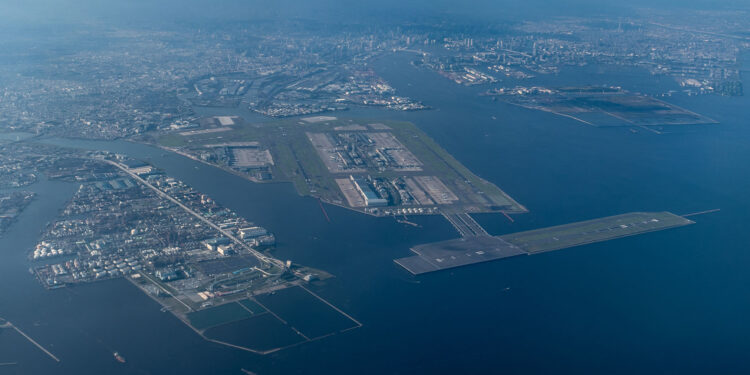Business Aviation Trip Planning Tips: Operations to Japan – PPRs and Permits

This is a post by author Hiroshi Higashiyama. Hiroshi is representative director for Universal Aviation Japan, which has aircraft ground handling facilities in Haneda, Narita, Sapporo, and Osaka. Hiroshi is an expert on business aircraft operations in Japan and can be contacted at hiroshihigashiyama@universalaviation.aero.
This aviation blog post is part of a series on operating to Japan and continues from our last article entitled “Business Aviation Trip Planning Tips: Operating to Japan – Navigating Airport Slots.”
Operations permits are required for many private non-revenue and charter (non-scheduled commercial) flight scenarios to Japan. These permits are normally arranged via ground handlers, and permit request lead times vary, depending on the flight plan.
If your operation is planning a trip to Japan, the following is an overview of what you need to know:
1. Know permit requirements for Japan
No Prior Permission Required (PPR) is needed for either private non-revenue or charter (non-scheduled commercial) flights to Japan. Operations permits, however, are necessary for all charter flights to and within Japan, and applying for them requires a full itinerary (more on documentation requirements is below).
In the case of private non-revenue flights, operations permits must be obtained for any planned domestic operations. Permit requests are submitted to Japan Civil Aviation Bureau (JACB) by mail or in person (fax or email is not acceptable), and requests must be in Japanese.
2. Cabotage is an issue for charter operations
Cabotage regulations were changed in 2013, alleviating some of the restrictions that were previously imposed. The changes still restrict charter operations from transporting passengers solely between two or more Japanese airports, but, in certain cases, operators may now make multiple stops in the country. For more information on the changes regarding cabotage, please see our article titled “Japan Flight Permit Changes – Improvements for Business Aviation.”
3. Permit request lead times vary
Your ground handler will normally be able to process operations permits within three business days. Permits for charter and non-International Civil Aviation Organization (ICAO) private flights require only three business days. In cases of short-notice trips for business purposes or emergency flights, JCAB may process permits within 24 hours on a case-by-case basis. It’s always recommended to use the services of a local ground handler when requesting permits for Japan. Processing lead time is typically 30 calendar days for permit requests submitted directly by an operator.
4. Know required documentation
For operations permits, JCAB requires the full itinerary, certificates of registration and airworthiness, noise certificate, worldwide insurance, flight number/call sign or tail number, crew/passenger information, and purpose of flight. In addition to this information, charter operators must provide a copy of the signed charter contract and the price paid for the flight. Note that charter flights may not be subcontracted from one company to another. Only flights chartered by the end-user customers are permitted in Japan.
5. Ferry flight permits can be processed quickly
JCAB will process operations permits for private non-revenue or charter ferry flights between two airports in Japan with just 24 hours’ lead time. No specific documentation is required, but the full schedule, tail number, and crew information are needed.
6. Permits may be obtained for operations into non-AOEs
It’s possible to set up approval to land at a non-Airport of Entry (AOE) – for first landing in Japan – or to depart the country from non-AOEs. These permits are processed through JCAB. You’ll also require approval from Customs, Immigration, and Quarantine to operate flights into and out of non-AOEs. Lead times vary from 24 hours to two weeks, depending upon location, and this is a process that should be coordinated with your ground handler.
7. Self-defense airports restrict GA operations
Self-defense airfields will not permit General Aviation (GA) operations, except in cases of air ambulance flights. For air ambulance flight permit requests, you’ll need to provide patient information, as well and doctor and hospital contact details, to gain landing approval.
8. Aircraft on experimental certificates require operations permits
To secure an operations permit for an aircraft with an experimental certificate, plan on 10 days’ lead time. You’ll need to provide airworthiness and registration certificates, a noise certificate, and worldwide insurance, along with any limitations noted on an experimental airworthiness certificate. If the airworthiness certificate has limitations on passengers, you must indicate the purpose of every passenger onboard.
9. Overflight permits are required in some cases
Japan only requires overflight permits for non-ICAO-registered aircraft and aircraft on experimental certificates. Permit lead time for non-ICAO-registered flights is three business days, while aircraft with experimental certificates require 10 days, as well as route of flight, entry/exit flight information regions, and crew information. Note that these permits are only valid for the schedule provided.
10. Know your permit validity
Permits for Japan, with the exception of overflight permits, are typically valid for a full calendar day. For permit revisions, only notification is required for changes to dates/times or crew/passengers. You will need to resubmit a new permit request, however, when adding or removing airport destinations or changing tail number.
Additional Information
JCAB is working to promote and ease GA business operations to Japan. To this end, the aviation authority is looking to deregulate many operational restrictions that are currently in place.
Questions?
If you have any questions about this article or operating to Japan, contact me at hiroshihigashiyama@universalaviation.aero.
Later we will discuss flight plans, weather, and NOTAMs for your trip to Japan.




